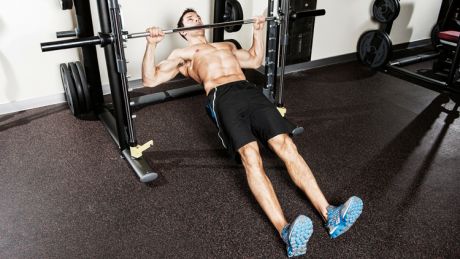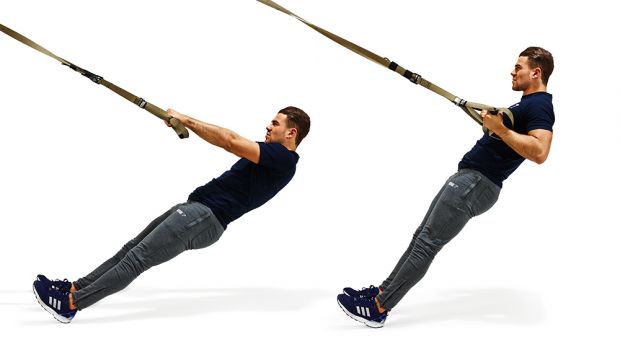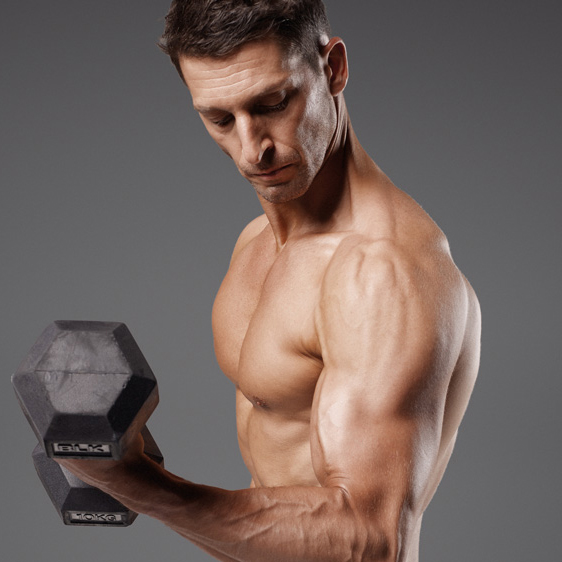How To Do The Inverted Row
Raise your body to a higher bar with the inverted row

Do you spend a lot of time in the gym working on your chest with bench presses or press-ups? Do you struggle with pull-ups? If your answer to either of those questions is yes, you need the inverted row in your life – and frankly even if your answer to both was no, it’s still an exercise worth knowing about.
That’s because the inverted row is one of the best all-round back exercises you can do, and it complements pressing exercises by balancing your gains across the muscles used. You don’t want to end up lopsided, right?
As a pulling exercise that uses your bodyweight, it also works as a stepping stone to the pull-up. So if you’re finding that your pull-up sets end after two or three reps, try spending a few weeks doing inverted rows to build up your strength.
You’ll also build muscle mass with the move, even without adding any extra resistance into the equation. Researchers measuring muscle activation in three different back exercises – the inverted row, the barbell bent-over row and the one-arm cable row – found that the greatest contractions in the upper back and lats came during the inverted row, according to the Journal Of Strength And Conditioning Research. The inverted row also produced the lowest load on the lumbar spine, so you can use it as your go-to back builder with less risk of hurting your lower back.
When you master the inverted row, not only will you feel your lats grow over time into a wondrous pair of wings, but the smaller muscle groups that help stabilise you – such as the rhomboids, mid-traps and infraspinatus – are all stimulated too. The result is a bigger, functionally strong back.
How To Do The Inverted Row
The first step is to select what you are going to hang from and row up to. In the gym, set up a Smith machine with a bar just out of reach when you’re lying on the ground; alternatively you can use TRX ropes (see the variations below) or gym rings.
Outside of the gym you’ll often find a suitable parallel bar in your local park, or you can even use a bike rack if you’ve taken your workout to the streets. At home it is possible to do inverted rows using a table, but it’s really important to make sure that table is sturdy and heavy enough that you can row from it without pulling it over on top of you. A better choice is a telescopic pull-up bar set in a door frame at the appropriate height.
Get the Coach Newsletter
Sign up for workout ideas, training advice, reviews of the latest gear and more.
Once your bar is set up, lie beneath it and grab it with both hands in an overhand grip (palms facing away from you). Brace your abs so your body forms a straight line from your head to your heels. Pull yourself up until your chest touches the bar, then lower slowly. If you’re struggling to get through your reps, move your feet closer to the bar and lift yourself up at a higher angle. Having your feet flat on the ground with a bend in the knees will halve the resistance involved and make the row easier.
Inverted Row Form Tips
Posture is key, so it’s important to avoid these three common mistakes:
1. The Chin Jab: You’re aiming to get your chest to the bar, not thrust your chin towards it and leave your body behind.
2. The Hip Sag: Dropping from the waist suggests your core isn’t up to the full inverted row, so start with your legs bent and your feet flat on the ground.
3. The Hip Thrust: The aim is to keep your body straight and move your chest to the bar, not fire your hips out like Bruno Mars.
Related
- How To Do The One-Arm Dumbbell Row
- How To Do The Upright Row
- How To Do A Renegade Row
- How To Do The Pendlay Row
Inverted Row Variations
Inverted row with legs raised
Once you’re comfortable with the standard movement, progress by elevating your legs on a box or flat bench to add extra range of motion. This works wonders for tapping into hard-to-work muscle fibres. Want to make it even harder? Rest your heels on a Bosu ball – this recruits more stabilising muscle fibres thanks to the unstable surface.
TRX inverted row

Using TRX ropes, or any suspension trainer, ups the ante because you are pulling against an unstable fixture, which means your core has to work harder to stabilise your body as you move. Most gyms now have TRX ropes, or gym rings that you can attach to a bar – simply adjust the handles so they’re just out of reach when you are lying on the ground beneath them.
Grab the handles with with your palms facing each other and form a straight plank position with just your heels touching the ground. Give more support to your lower back by making your core as tight as possible before a set. Do this by bracing yourself as if you were about to be punched in the stomach. Pull your chest up so it’s in line with your hands, keeping your body straight, then lower.
As with the standard inverted row, moving your feet closer to the handles makes the exercise easier, and moving them further away or resting them on an elevated surface or Bosu ball makes it harder.
Superset TRX rows with TRX press-ups with your feet in the handles (or with your hands in them to make it harder) and you’ll transform your torso. Do ten rows, rest 30 seconds, then do ten press-ups and rest for 60 seconds, completing three to five supersets in total.
Single-arm inverted row
Half the arms means twice the fun. Well, maybe fun isn’t the right word – twice the challenge is more appropriate. The single-arm version of the exercise not only makes it tougher on your back muscles, but also introduces an extra test for your core strength, because you’ll be working to resist rotating your body during the exercise and keep your torso in position.
Hold the bar with one hand and row your chest up towards it, the lower slowly back down. It’s best to keep your legs fairly close to the bar when you first try this variation, because it’s even harder than you might imagine. Move your legs further away throughout the set once you can gauge your single-arm strength.
Single-arm rotational inverted row
With the standard single-arm inverted row you work to resist rotation, but with this variation you embrace it. This row is best performed with a suspension trainer. Row your chest up towards the handle with one hand, then rotate the other hand towards the floor and turn your chest as you come back down so you end up in a side plank position hanging from the handle. Twist your body back around as you row your chest towards the handle again. Rotating down and back up increases the challenge to your core and hits the obliques particularly hard.

Joe Warner is a highly experienced journalist and editor who began working in fitness media in 2008. He has featured on the cover of Men’s Fitness UK twice and has co-authored Amazon best-sellers including 12-Week Body Plan. He was the editor of Men’s Fitness UK magazine between 2016 and 2019, when that title shared a website with Coach.









